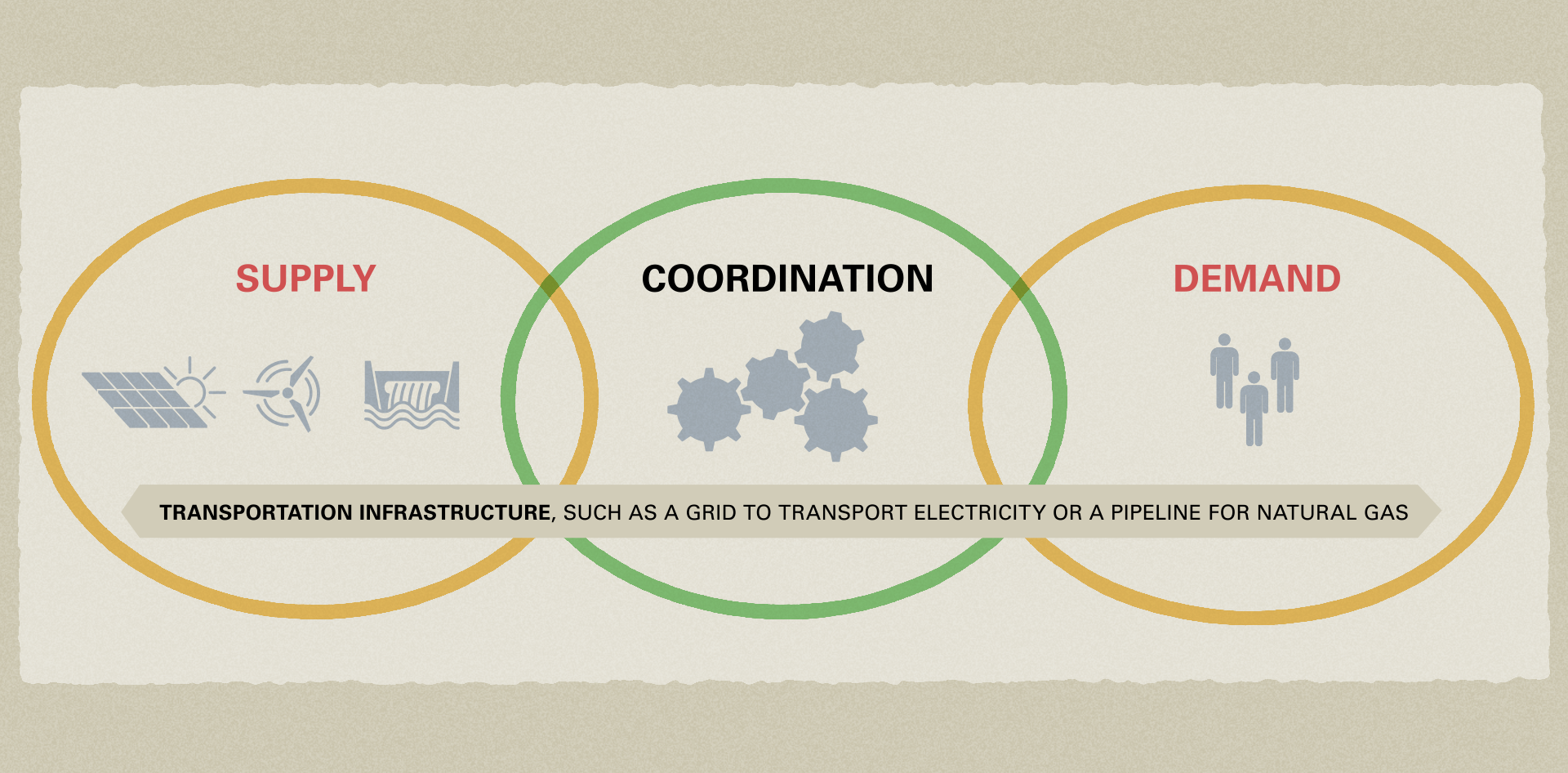DIVING INTO THE CASE: THE ENERGY SYSTEM AND TRANSITION
3.1
Energy system overview
Energy has several peculiar characteristics and energy systems and therefore some demanding tasks to fulfil.
An energy system consists of three main elements: Supply, demand, and the institutions that coordinate supply and demand. Depending on the energy carrier, a fourth element might also be important: transportation infrastructure, such as a grid to transport electricity or a pipeline for natural gas.
 The three main elements of an energy system. © New Media Center
The three main elements of an energy system. © New Media Center
Furthermore, there are several specific characteristics of energy.
Firstly, energy is rarely consumed directly. We do not get well-being from placing our finger in a socket and “consuming” electricity directly. Rather, we want to use services, such as communication services, that are supplied by technologies that require electricity to work. This implies that end-users are typically not particular about what type of energy they use; most people could live well with oil-based or electricity-based heating, as long as their living spaces are at a comfortable temperature.
Secondly, despite this point, energy is one of the most important commodities in a society. If the power supply collapses, this has several consequences. Companies cannot produce, which leads to loss of income. Houses become cold or hot depending on the climate; some of the population develop health problems as a result. There is no telecommunications, there is little or no public transport, hospitals no longer function, etc. The costs of major blackouts can easily run into billions of dollars, even for small countries like Switzerland. Thus, a reliable energy supply is of major importance.
Thirdly, during the past century, the energy systems of most countries have moved from energy carriers that are easily storable, such as biomass, to carriers that are expensive to store in large quantities, such as electricity or natural gas. The expected electrification of mobility and space heating is likely to amplify this trend. The result is that supply and demand have to be carefully coordinated. In the case of electricity, supply and demand have to be perfectly matched on a second-by-second level. This requires sophisticated institutions.
Finally, we have not yet found the “silver bullet” in terms of supplying and distributing energy. All energy carriers have their advantages and problems. Fossil fuels contribute to climate change and stocks are limited; therefore we are aiming to move away from these energy sources.
Choosing an energy system
Renewable energies such as photovoltaics (PV), wind, hydropower or biomass often require large investments, often considerable amounts of land, and production is often dependent on weather conditions.
Nuclear fission poses the risk of contamination and the problem of storing nuclear waste. Nuclear fusion is still not much more than a dream and likely to have problems of its own, once the dream becomes reality.
This means that we have to choose between problems that we want to avoid and ones that we can accept, at least temporarily. This does not only apply to the supply side, but also to other parts of the energy system. If we want to have lower costs or less environmental impact, we would have to reduce energy demand. But this might require high prices, resulting in potentially problematic distributional effects in society, and might limit the use of services that some parts of the population deem to be important for their life, such as recreational travelling.
Therefore, choosing an energy system means choosing among multiple trade-offs. This is why the idea of sustainable development can be helpful here, as sustainability provides some insight into how to make these choices.
The Swiss energy system
To describe these trade-offs, it is important to have an overview of the energy system. We will give this overview using the Swiss energy system as an example and point out some special features, i.e. aspects that might be different in other countries.
In 2021, Switzerland – which has a population of 8.7 million and a GDP of 800 billion USD – used about 800 Terajoules of energy. Roughly 30% of the energy was used by households (excluding mobility), 37% by industry and services, and about 32% for transportation and mobility.
Fossil fuels (oil-based fuels and natural gas) provided about 59% of the energy, 26% was electricity, and 15% by other carriers, such as district heating, biomass, geothermal energy, or solar heating. Most of this energy was imported, as Switzerland has no substantial domestic sources of fossil fuels and about 29% of the electricity is provided by nuclear power that depends on imported uranium (Bundesamt für Energie, 2021a).
Whereas there is currently only limited use of renewables outside of the electricity domain, Switzerland has a largely renewable electricity supply. Its topology and rainfall patterns allow for substantial hydropower use (roughly 61% of electricity supply). Other renewables, such as PV or wind power, contribute about 6% of the overall electricity supply (Bundesamt für Energie, 2021b).
As far as the use of energy services is concerned, space heating dominates due to the climate in Switzerland, with roughly 34% of total energy used for this service. Mobility services come second (29%), followed by process heat for industry (12%) and other use of energy in industry and services (9%). This pattern is surprisingly stable, with little change during the past two decades (Bundesamt für Energie, 2021c).
In the following steps, we will dive more deeply into supply, demand, the importance of energy services for well-being, and the governance of the energy system.
Author: Frank Krysiak
References
Bundesamt für Energie (2021a). Schweizerische Gesamtenergiestatistik 2021. (in German)
Bundesamt für Energie (2021b). Schweizerische Elektrizitätsstatistik 2021. (in German)
